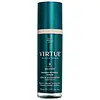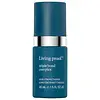What's inside
What's inside
 Key Ingredients
Key Ingredients

 Benefits
Benefits

 Concerns
Concerns

 Ingredients Side-by-side
Ingredients Side-by-side

Water
Skin ConditioningC13-15 Alkane
SolventCoconut Alkanes
EmollientPropanediol
SolventGlycerin
HumectantAmmonium Acryloyldimethyltaurate/Vp Copolymer
Salvia Hispanica Seed Extract
EmollientKeratin
Skin ConditioningPolyglyceryl-3 Methylglucose Distearate
EmulsifyingSqualane
EmollientQuercus Petraea Fruit Extract
Skin ConditioningCopper Tripeptide-34
Skin ConditioningPalmitoyl Dipeptide-52
Skin ConditioningCitrus Paradisi Fruit Extract
Skin ConditioningCamellia Sinensis Leaf Extract
AntimicrobialPanthenol
Skin ConditioningArginine
MaskingHydrolyzed Vegetable Protein
Skin ConditioningLinum Usitatissimum Seed Extract
PerfumingQuaternium-95
UV AbsorberHydrogenated Olive Oil Unsaponifiables
EmollientOryza Sativa Extract
AbsorbentCaesalpinia Spinosa Fruit Pod Extract
Lauryl Glucoside
CleansingJojoba Esters
EmollientPolyglyceryl-6 Laurate
EmulsifyingShea Butter Ethyl Esters
EmollientHydrogenated Ethylhexyl Olivate
EmollientMyristyl Glucoside
CleansingCoco-Caprylate/Caprate
EmollientTremella Fuciformis Polysaccharide
Emulsion StabilisingOryza Sativa Bran Water
MaskingCentella Asiatica Extract
CleansingEthylhexylglycerin
Skin ConditioningHydroxypropyltrimonium Hydrolyzed Rice Protein/Siloxysilicate
Helianthus Annuus Seed Oil
EmollientPolyglyceryl-10 Laurate
Skin ConditioningPhospholipids
Skin ConditioningHydrolyzed Linseed Seed
HumectantSodium Dilauramidoglutamide Lysine
HumectantPopulus Tremuloides Bark Extract
AntiseborrhoeicTocopherol
AntioxidantRosmarinus Officinalis Leaf Extract
AntimicrobialOryza Sativa Bran Extract
Skin ConditioningItaconic Acid
AntimicrobialSodium Phytate
Oryza Sativa Seed Protein
AntioxidantXylitol
HumectantPhytic Acid
Citric Acid
BufferingCaprylyl Glycol
EmollientHelianthus Annuus Sprout Extract
Skin ConditioningCalcium Gluconate
HumectantCaprylic Acid
CleansingParfum
MaskingGalactoarabinan
Gluconolactone
Skin ConditioningTrehalose
HumectantMaltodextrin
AbsorbentLeuconostoc/Radish Root Ferment Filtrate
AntimicrobialPhenoxyethanol
PreservativeChlorphenesin
AntimicrobialSodium Hydroxide
BufferingSodium Benzoate
MaskingSodium Phosphate
BufferingPotassium Sorbate
PreservativeBenzyl Salicylate
PerfumingCoumarin
PerfumingLimonene
PerfumingGeraniol
PerfumingHexyl Cinnamal
PerfumingLinalool
PerfumingWater, C13-15 Alkane, Coconut Alkanes, Propanediol, Glycerin, Ammonium Acryloyldimethyltaurate/Vp Copolymer, Salvia Hispanica Seed Extract, Keratin, Polyglyceryl-3 Methylglucose Distearate, Squalane, Quercus Petraea Fruit Extract, Copper Tripeptide-34, Palmitoyl Dipeptide-52, Citrus Paradisi Fruit Extract, Camellia Sinensis Leaf Extract, Panthenol, Arginine, Hydrolyzed Vegetable Protein, Linum Usitatissimum Seed Extract, Quaternium-95, Hydrogenated Olive Oil Unsaponifiables, Oryza Sativa Extract, Caesalpinia Spinosa Fruit Pod Extract, Lauryl Glucoside, Jojoba Esters, Polyglyceryl-6 Laurate, Shea Butter Ethyl Esters, Hydrogenated Ethylhexyl Olivate, Myristyl Glucoside, Coco-Caprylate/Caprate, Tremella Fuciformis Polysaccharide, Oryza Sativa Bran Water, Centella Asiatica Extract, Ethylhexylglycerin, Hydroxypropyltrimonium Hydrolyzed Rice Protein/Siloxysilicate, Helianthus Annuus Seed Oil, Polyglyceryl-10 Laurate, Phospholipids, Hydrolyzed Linseed Seed, Sodium Dilauramidoglutamide Lysine, Populus Tremuloides Bark Extract, Tocopherol, Rosmarinus Officinalis Leaf Extract, Oryza Sativa Bran Extract, Itaconic Acid, Sodium Phytate, Oryza Sativa Seed Protein, Xylitol, Phytic Acid, Citric Acid, Caprylyl Glycol, Helianthus Annuus Sprout Extract, Calcium Gluconate, Caprylic Acid, Parfum, Galactoarabinan, Gluconolactone, Trehalose, Maltodextrin, Leuconostoc/Radish Root Ferment Filtrate, Phenoxyethanol, Chlorphenesin, Sodium Hydroxide, Sodium Benzoate, Sodium Phosphate, Potassium Sorbate, Benzyl Salicylate, Coumarin, Limonene, Geraniol, Hexyl Cinnamal, Linalool
Water
Skin ConditioningCetyl Alcohol
EmollientGlyceryl Stearate
EmollientIsodecyl Oleate
EmollientIsopentyldiol
HumectantDioctyldodecyl Dodecanedioate
EmollientSodium Phytate
Phytosteryl/Octyldodecyl Lauroyl Glutamate
Skin ConditioningOlea Europaea Leaf Extract
PerfumingHelianthus Annuus Seed Wax
Skin ConditioningJojoba Esters
EmollientLinoleamidopropyl Dimethylamine Dimer Dilinoleate
Skin ConditioningC10-18 Triglycerides
EmollientRicinus Communis Seed Oil
MaskingGlyceryl Ricinoleate
EmollientCyclodextrin
AbsorbentPropanediol
SolventGlycerin
HumectantPentylene Glycol
Skin ConditioningCeteth-20
CleansingSteareth-20
CleansingPEG-75 Stearate
Polyglycerin-3
HumectantHydroxypropyl Methylcellulose
Emulsion StabilisingCyamopsis Tetragonoloba Gum
Emulsion StabilisingHydroxyethylcellulose
Emulsion StabilisingXanthan Gum
EmulsifyingCaesalpinia Spinosa Gum
Skin ConditioningParfum
MaskingCitric Acid
BufferingSodium Hydroxide
BufferingGluconic Acid
Hydroxyacetophenone
AntioxidantSodium Benzoate
MaskingLinalool
PerfumingHexyl Cinnamal
PerfumingCitronellol
PerfumingCitral
PerfumingLimonene
PerfumingWater, Cetyl Alcohol, Glyceryl Stearate, Isodecyl Oleate, Isopentyldiol, Dioctyldodecyl Dodecanedioate, Sodium Phytate, Phytosteryl/Octyldodecyl Lauroyl Glutamate, Olea Europaea Leaf Extract, Helianthus Annuus Seed Wax, Jojoba Esters, Linoleamidopropyl Dimethylamine Dimer Dilinoleate, C10-18 Triglycerides, Ricinus Communis Seed Oil, Glyceryl Ricinoleate, Cyclodextrin, Propanediol, Glycerin, Pentylene Glycol, Ceteth-20, Steareth-20, PEG-75 Stearate, Polyglycerin-3, Hydroxypropyl Methylcellulose, Cyamopsis Tetragonoloba Gum, Hydroxyethylcellulose, Xanthan Gum, Caesalpinia Spinosa Gum, Parfum, Citric Acid, Sodium Hydroxide, Gluconic Acid, Hydroxyacetophenone, Sodium Benzoate, Linalool, Hexyl Cinnamal, Citronellol, Citral, Limonene
Alternatives
Ingredients Explained
These ingredients are found in both products.
Ingredients higher up in an ingredient list are typically present in a larger amount.
Citric Acid is an alpha hydroxy acid (AHA) naturally found in citrus fruits like oranges, lemons, and limes.
Like other AHAs, citric acid can exfoliate skin by breaking down the bonds that hold dead skin cells together. This helps reveal smoother and brighter skin underneath.
However, this exfoliating effect only happens at high concentrations (20%) which can be hard to find in cosmetic products.
Due to this, citric acid is usually included in small amounts as a pH adjuster. This helps keep products slightly more acidic and compatible with skin's natural pH.
In skincare formulas, citric acid can:
While it can provide some skin benefits, research shows lactic acid and glycolic acid are generally more effective and less irritating exfoliants.
Most citric acid used in skincare today is made by fermenting sugars (usually from molasses). This synthetic version is identical to the natural citrus form but easier to stabilize and use in formulations.
Read more about some other popular AHA's here:
Learn more about Citric AcidGlycerin is already naturally found in your skin. It helps moisturize and protect your skin.
A study from 2016 found glycerin to be more effective as a humectant than AHAs and hyaluronic acid.
As a humectant, it helps the skin stay hydrated by pulling moisture to your skin. The low molecular weight of glycerin allows it to pull moisture into the deeper layers of your skin.
Hydrated skin improves your skin barrier; Your skin barrier helps protect against irritants and bacteria.
Glycerin has also been found to have antimicrobial and antiviral properties. Due to these properties, glycerin is often used in wound and burn treatments.
In cosmetics, glycerin is usually derived from plants such as soybean or palm. However, it can also be sourced from animals, such as tallow or animal fat.
This ingredient is organic, colorless, odorless, and non-toxic.
Glycerin is the name for this ingredient in American English. British English uses Glycerol/Glycerine.
Learn more about GlycerinHexyl Cinnamal is a fragrance ingredient with a similar scent to jasmine. It can be naturally found in chamomile essential oil.
This ingredient is a known EU allergen and may sensitize the skin. The EU requires this ingredient to be listed separately on an ingredients list.
Hexyl Cinnamal is not water soluble but is soluble in oils.
Learn more about Hexyl CinnamalJojoba Esters is a wax created from Jojoba oil. It is an emollient and film-forming ingredient. In bead form, it is an exfoliator.
This ingredient has high oxidative stability, meaning it doesn't break down when exposed to oxygen.
Its similarity to our skin's natural oils makes it a great emollient. Emollients help soften and soothe our skin by creating a barrier on top. This barrier helps trap moisture in, keeping skin hydrated.
It is created using either the hydrogenation or transesterification processes on jojoba oil.
Learn more about Jojoba EstersLimonene is a fragrance that adds scent and taste to a formulation.
It's found in the peel oil of citrus fruits and other plants such as lavender and eucalyptus. The scent of limonene is generally described as "sweet citrus".
Limonene acts as an antioxidant, meaning it helps neutralize free radicals.
When exposed to air, oxidized limonene may sensitize the skin. Because of this, limonene is often avoided by people with sensitive skin.
The term 'fragrance' is not regulated in many countries. In many cases, it is up to the brand to define this term. For instance, many brands choose to label themselves as "fragrance-free" because they are not using synthetic fragrances. However, their products may still contain ingredients such as essential oils that are considered a fragrance.
Learn more about LimoneneLinalool is a fragrance and helps add scent to products. It's derived from common plants such as cinnamon, mint, citrus, and lavender.
Like Limonene, this ingredient oxidizes when exposed to air. Oxidized linalool can cause allergies and skin sensitivity.
This ingredient has a scent that is floral, spicy tropical, and citrus-like.
Learn more about LinaloolParfum is a catch-all term for an ingredient or more that is used to give a scent to products.
Also called "fragrance", this ingredient can be a blend of hundreds of chemicals or plant oils. This means every product with "fragrance" or "parfum" in the ingredients list is a different mixture.
For instance, Habanolide is a proprietary trade name for a specific aroma chemical. When used as a fragrance ingredient in cosmetics, most aroma chemicals fall under the broad labeling category of “FRAGRANCE” or “PARFUM” according to EU and US regulations.
The term 'parfum' or 'fragrance' is not regulated in many countries. In many cases, it is up to the brand to define this term.
For instance, many brands choose to label themselves as "fragrance-free" because they are not using synthetic fragrances. However, their products may still contain ingredients such as essential oils that are considered a fragrance by INCI standards.
One example is Calendula flower extract. Calendula is an essential oil that still imparts a scent or 'fragrance'.
Depending on the blend, the ingredients in the mixture can cause allergies and sensitivities on the skin. Some ingredients that are known EU allergens include linalool and citronellol.
Parfum can also be used to mask or cover an unpleasant scent.
The bottom line is: not all fragrances/parfum/ingredients are created equally. If you are worried about fragrances, we recommend taking a closer look at an ingredient. And of course, we always recommend speaking with a professional.
Learn more about ParfumPropanediol is an all-star ingredient. It softens, hydrates, and smooths the skin.
It’s often used to:
Propanediol is not likely to cause sensitivity and considered safe to use. It is derived from corn or petroleum with a clear color and no scent.
Learn more about PropanediolSodium Benzoate is a preservative. It's used in both cosmetic and food products to inhibit the growth of mold and bacteria. It is typically produced synthetically.
Both the US FDA and EU Health Committee have approved the use of sodium benzoate. In the US, levels of 0.1% (of the total product) are allowed.
Sodium benzoate works as a preservative by inhibiting the growth of bacteria inside of cells. It prevents the cell from fermenting a type of sugar using an enzyme called phosphofructokinase.
It is the salt of benzoic acid. Foods containing sodium benzoate include soda, salad dressings, condiments, fruit juices, wines, and snack foods.
Studies for using ascorbic acid and sodium benzoate in cosmetics are lacking, especially in skincare routines with multiple steps.
We always recommend speaking with a professional, such as a dermatologist, if you have any concerns.
Learn more about Sodium BenzoateSodium Hydroxide is also known as lye or caustic soda. It is used to adjust the pH of products; many ingredients require a specific pH to be effective.
In small amounts, sodium hydroxide is considered safe to use. However, large amounts may cause chemical burns due to its high alkaline.
Your skin has a natural pH and acid mantle. This acid mantle helps prevent harmful bacteria from breaking through. The acid mantle also helps keep your skin hydrated.
"Alkaline" refers to a high pH level. A low pH level would be considered acidic.
Learn more about Sodium HydroxideSodium Phytate is the synthetic salt form of phytic acid. Phytic acid is an antioxidant and can be found in plant seeds.
Sodium Phytate is a chelating agent. Chelating agents help prevent metals from binding to water. This helps stabilize the ingredients and the product.
Water. It's the most common cosmetic ingredient of all. You'll usually see it at the top of ingredient lists, meaning that it makes up the largest part of the product.
So why is it so popular? Water most often acts as a solvent - this means that it helps dissolve other ingredients into the formulation.
You'll also recognize water as that liquid we all need to stay alive. If you see this, drink a glass of water. Stay hydrated!
Learn more about Water